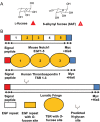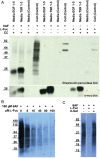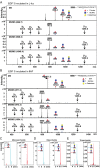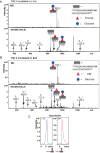6-alkynyl fucose is a bioorthogonal analog for O-fucosylation of epidermal growth factor-like repeats and thrombospondin type-1 repeats by protein O-fucosyltransferases 1 and 2
- PMID: 23045360
- PMCID: PMC3531295
- DOI: 10.1093/glycob/cws140
6-alkynyl fucose is a bioorthogonal analog for O-fucosylation of epidermal growth factor-like repeats and thrombospondin type-1 repeats by protein O-fucosyltransferases 1 and 2
Abstract
Protein O-fucosyltransferase 1 (Pofut1) and protein O-fucosyltransferase 2 (Pofut2) add O-linked fucose at distinct consensus sequences in properly folded epidermal growth factor (EGF)-like repeats and thrombospondin type-1 (TSR) repeats, respectively. Glycan chain elongation past O-fucose can occur to yield a tetrasaccharide on EGF repeats and a disaccharide on TSRs. Elimination of Pofut1 in mice causes embryonic lethality with Notch-like phenotypes demonstrating that O-fucosylation of Notch is essential for its function. Similarly, elimination of Pofut2 results in an early embryonic lethal phenotype in mice, although the molecular mechanism for the lethality is unknown. The recent development of sugar analogs has revolutionized the study of glycans by providing a convenient method for labeling and tracking glycosylation. In order to study O-fucosylation, we took advantage of the recently developed reporter, 6-alkynyl fucose. Using the Cu(I)-catalyzed azide-alkyne cycloaddition (CuAAC), or "click" reaction, azido-biotin allows tagging and detection of 6AF-modified proteins. Here we examine whether proteins containing EGF repeats or TSRs with O-fucose consensus sequences are specifically modified with 6AF in cell culture. Using mass spectrometry (MS), we demonstrate that 6AF is efficiently incorporated onto the appropriate consensus sequences on EGF repeats and TSRs. Furthermore, the elongation of the O-fucose monosaccharide on EGF repeats and TSRs is not hampered when 6AF is used. These results show that 6AF is efficiently utilized in a truly bioorthogonal manner by Pofut1, Pofut2 and the enzymes that elongate O-fucose, providing evidence that 6AF is a significant new tool in the study of protein O-fucosylation.
Figures





Similar articles
-
Two distinct pathways for O-fucosylation of epidermal growth factor-like or thrombospondin type 1 repeats.J Biol Chem. 2006 Apr 7;281(14):9385-92. doi: 10.1074/jbc.M511974200. Epub 2006 Feb 7. J Biol Chem. 2006. PMID: 16464858
-
O-fucosylation stabilizes the TSR3 motif in thrombospondin-1 by interacting with nearby amino acids and protecting a disulfide bond.J Biol Chem. 2022 Jun;298(6):102047. doi: 10.1016/j.jbc.2022.102047. Epub 2022 May 18. J Biol Chem. 2022. PMID: 35597280 Free PMC article.
-
O-Glycosylation modulates the stability of epidermal growth factor-like repeats and thereby regulates Notch trafficking.J Biol Chem. 2017 Sep 22;292(38):15964-15973. doi: 10.1074/jbc.M117.800102. Epub 2017 Jul 20. J Biol Chem. 2017. PMID: 28729422 Free PMC article.
-
A perspective on structural and mechanistic aspects of protein O-fucosylation.Acta Crystallogr F Struct Biol Commun. 2018 Aug 1;74(Pt 8):443-450. doi: 10.1107/S2053230X18004788. Epub 2018 Jul 26. Acta Crystallogr F Struct Biol Commun. 2018. PMID: 30084393 Free PMC article. Review.
-
Protein O-fucosylation: structure and function.Curr Opin Struct Biol. 2019 Jun;56:78-86. doi: 10.1016/j.sbi.2018.12.005. Epub 2019 Jan 26. Curr Opin Struct Biol. 2019. PMID: 30690220 Free PMC article. Review.
Cited by
-
The Function of Fucosylation in Progression of Lung Cancer.Front Oncol. 2018 Dec 7;8:565. doi: 10.3389/fonc.2018.00565. eCollection 2018. Front Oncol. 2018. PMID: 30619732 Free PMC article. Review.
-
A proactive role of water molecules in acceptor recognition by protein O-fucosyltransferase 2.Nat Chem Biol. 2016 Apr;12(4):240-6. doi: 10.1038/nchembio.2019. Epub 2016 Feb 8. Nat Chem Biol. 2016. PMID: 26854667 Free PMC article.
-
Chemical Lectinology: Tools for Probing the Ligands and Dynamics of Mammalian Lectins In Vivo.Chem Biol. 2015 Aug 20;22(8):983-93. doi: 10.1016/j.chembiol.2015.07.009. Epub 2015 Aug 6. Chem Biol. 2015. PMID: 26256477 Free PMC article. Review.
-
Protein O-fucosyltransferase 1 expression impacts myogenic C2C12 cell commitment via the Notch signaling pathway.Mol Cell Biol. 2015 Jan;35(2):391-405. doi: 10.1128/MCB.00890-14. Epub 2014 Nov 10. Mol Cell Biol. 2015. PMID: 25384974 Free PMC article.
-
Marine Antibody-Drug Conjugates: Design Strategies and Research Progress.Mar Drugs. 2017 Jan 13;15(1):18. doi: 10.3390/md15010018. Mar Drugs. 2017. PMID: 28098746 Free PMC article. Review.
References
-
- Becker DJ, Lowe JB. Fucose: Biosynthesis and biological function in mammals. Glycobiology. 2003;13:41R–53R. doi:10.1093/glycob/cwg054. - DOI - PubMed
-
- Besanceney-Webler C, Jiang H, Wang W, Baughn AD, Wu P. Metabolic labeling of fucosylated glycoproteins in Bacteroidales species. Bioorg Med Chem Lett. 2011;21:4989–4992. doi:10.1016/j.bmcl.2011.05.038. - DOI - PMC - PubMed
-
- Bruckner K, Perez L, Clausen H, Cohen S. Glycosyltransferase activity of Fringe modulates Notch-Delta interactions. Nature. 2000;406:411–415. doi:10.1038/35019075. - DOI - PubMed
-
- Dehnert KW, Baskin JM, Laughlin ST, Beahm BJ, Naidu NN, Amacher SL, Bertozzi CR. Imaging the sialome during zebrafish development with copper-free click chemistry. Chembiochem. 2012;13:353–357. doi:10.1002/cbic.201100649. - DOI - PMC - PubMed
Publication types
MeSH terms
Substances
Grants and funding
LinkOut - more resources
Full Text Sources
Miscellaneous

